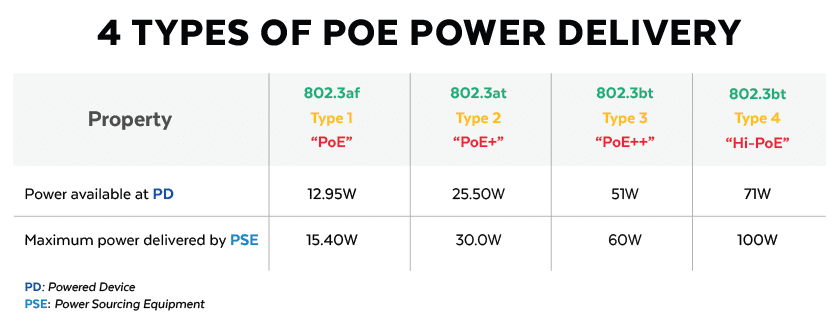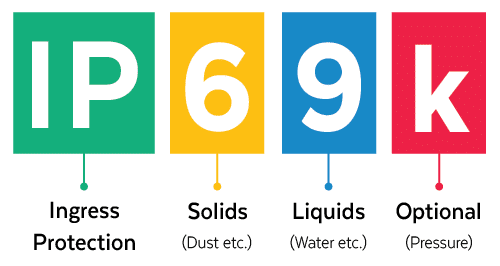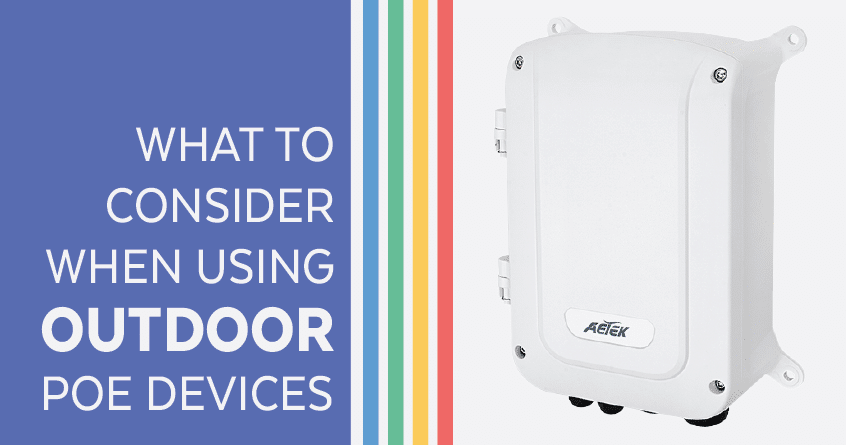There are a number of challenges when installing and maintaining powered devices (PDs) in outdoor environments. Dust, water, ultraviolet light, varying temperature swings, and sometimes even lightning conditions can become extreme and call for an extra layer of protection for an organization’s vital outdoor PDs. Before we dive into how outdoor PoE can help, let’s understand the available options.
When powering outdoor installations, there are two main options available:
- Ethernet devices can be powered by AC, which requires electrical outlets and the services of a licensed electrician.
- PDs can be powered using Power over Ethernet (PoE) technology that supplies both power and data over a single Ethernet cable. There is no need for electrical outlets or expensive electricians to install PoE.
This article addresses the revolutionary PoE solution to powering outdoor installations.
First, a Few Words About PoE
PoE enables a single RJ45 cable to provide both electric power and data connection to PDs, thus cutting the cable requirements by half. In addition, PoE technology uses low wattage power to do the job. This means safe power without the need for an expensive electrician.
PoE comes in four standards that have been ratified by the Institute of Electrical and Electronics Engineers (IEEE). These standards are as follows:
- IEEE 802.3af (PoE) with a maximum of 15.4 watts (W) and 12.95W available to the PD
- IEEE 802.3at (PoE+) with a maximum of 30W and 25.50W available to the PD
- IEEE 802.3bt Type 3 (PoE++) with a maximum of 60W and 51W available to the PD
- IEEE 802.3bt Type 4 (Hi-PoE) with a maximum of 100W and 71W available to the PD
 Why We Recommend POE
Why We Recommend POE
There are many benefits of PoE technology, no matter the environment (inside or outside). Power over Ethernet technology:
- Saves money: PoE uses half the cabling than traditional AC installations. Plus, there is no need for professional electrician installers.
- Is flexible: PDs can be placed in nearly any location as there is no need for electrical wall outlets. In addition, add-ons and changes are quick and easy.
- Is safe: Low wattage means low risk. Also, PoE has built-in safety protocols to protect against PD damage.
- Is reliable: PoE relies on Ethernet, a well-known and wholly vetted technology, and it can be easily incorporated into an existing network.
- Scalable: PoE devices are “plug-and-play,” making adding new equipment to the network easy.
Outdoor PoE is a Great Solution for Your Business
One of the most common pieces of outdoor equipment for all types of business is the IP security camera powered with PoE technology. In addition, there are many other important applications for outdoor-quality PoE devices. That list includes:
- Outdoor advertising (digital signage)
- Outdoor lighting (string lights, outdoor fixtures, pathway and security lighting, etc.)
- Outdoor kiosks
- Wireless access points (WAPs)
- And more!
What to Consider for Outdoor PoE Solutions
Before installing a PD in an outside environment, it is vital to consider the level of protection needed from:
- Dust
- Water
- Ultraviolet (UV) light
- Lightning
- Temperature extremes (from hot to cold)
In addition, you will need to ascertain:
- The NEMA rating of the device enclosure
- The device’s flame classification
- The data rate the application needs
- The level of PoE required by the device
- Any physical installation requirements (e.g., wall, pole, etc.)
Let’s look at some of these considerations a bit more closely.
Dust and Water Protection
The requirements for outdoor deployment of electrical equipment are defined by the International Electrotechnical Commission (IE) standard 60529. IEC 60529 establishes an Ingress Protection Rating (called an IP code) that measures a device’s resistance to solids (like dust) and water.
For example, let’s use an IP code of IP69K. If a device has this rating, it will have the highest resistance to solid and water possible. This is how it works:
- The first digit in the code (in this case, the number 6) is the rating for resistance to solids. The ratings for solids go from 0 to 6.
- The second digit in the code (in this case, the number 9K) is the rating for water resistance. The rating for water ranges from 0 to 9.
 NEMA Enclosure Type
NEMA Enclosure Type
The United States National Electrical Manufacturers Association (NEMA) rates the degree a device’s enclosure protects against corrosion. NEMA ratings range from 1 to 4X. A 4X means the device in question is safe fully submerged in a marine environment or even in a nuclear facility.
UV Protection
A device with an Underwriters Laboratory (UL) rating of 60950-22 is sufficiently resistant to UV exposure. In addition, you can be assured that any device with this rating has been tested and approved for outdoor use.
Flame Classification
UL 94 is a plastics flame-retardant classification. Six flame categories within this standard describe a material’s burning characteristics. PoE outdoor devices require a 5VB rating, so make sure any equipment you purchase is approved at this level.
Surge/Lightning Protection
The leading causes of power surges are:

- Electrical overload
- Faulty wiring
- Lightning strikes
- Power restoration after a power outage or blackout
No matter the source of a surge, it is essential to note that they can damage the internal circuitry of an end-point device and can even reach and damage expensive indoor units. Therefore, the best practice for outdoor surge protection is to install two surge protectors per PoE device—one just before the end-point PoE PD and the other just before the nearest PoE switch.
Note: Remember that any surge protector chosen for outdoor use must be able to withstand conditions such as extreme heat, humidity, dust, rain, snow, and ice.
Temperature Range
It is crucial that any outdoor device installed can function within the temperature ranges typical of its location. In locations with low temperatures, look for devices that support
-40°C/-40°F. In hot climates, look for devices that support 55°C/131°F.
Choose Your Outdoor PoE Devices
Versa Technology’s outdoor-grade PoE devices are built to more than meet the many challenges of an outside environment. We have an extensive inventory of hardened PoE switches, PoE injectors, PoE extenders, PoE splitters, and surge protectors from which to choose. It is our sincere belief that PoE’s inherent reliability, affordability, and safety make it the best technology to power a business’s outdoor installation needs.
Have you got any questions? We want to help you. Contact us today!

